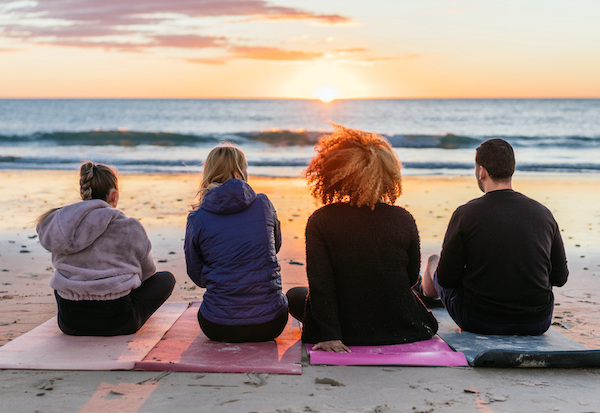
Are you looking for a low-impact way to improve your flexibility, strength, and range of motion? Aqua yoga is a form of yoga that is practiced in water, usually in a swimming pool. The buoyancy of the water makes it easier to move into different yoga poses, while also reducing the risk of falls or injuries.
This type of yoga is a great option for people who have joint pain or other physical limitations that make traditional yoga or other types of yoga more arduous. The water provides a supportive environment that can help you move more freely and comfortably. Plus, the coolness of the water can be refreshing and invigorating, making your yoga practice even more enjoyable. Whether you’re a seasoned yogi or a beginner, practicing yoga in the water is a fun and effective way to improve your overall health and wellness.
Table of Contents
What is Aqua Yoga?
Also known as water yoga, is a type of yoga that involves performing yoga poses in a body of water. This can be in an indoor or outdoor swimming pool, hot tub, spa, lake, pond, or ocean. The water provides a unique environment that can enhance the yoga experience by adding resistance, buoyancy, and support.
The practice is gentle and low impact, making it accessible to people of all ages and fitness levels. It can also provide a sense of relaxation and tranquility. The sound and feel of the water can help to calm the mind and reduce stress levels.
Overall, it is a unique way to practice yoga that can provide numerous physical and mental benefits.
Who can do Aqua Yoga?
As it is a low-impact exercise, it’s suitable for people of all ages and fitness levels. It is an excellent way to get a full-body workout without putting too much strain on your joints. Here are some groups of people who can benefit from its practice:
Seniors
As we age, our bodies become more prone to injury, and our joints become stiffer. Aqua Yoga is an excellent alternative to classic Yoga for seniors to stay active without putting too much strain on their bodies. The water provides a low-impact environment that reduces the risk of injury and makes it easier to move.
Pregnant Women
Pregnancy can be a challenging time for many women, and it can be difficult to find exercise routines that are safe and effective. Practicing yoga in the water is an excellent option for pregnant women because the water provides support for the body and reduces the risk of injury. It can also help alleviate some of the discomforts associated with pregnancy, such as back pain and swelling.
People with Injuries or Chronic Pain
If you have an injury or chronic pain, it can be hard to find exercise routines that are safe and effective. Aqua Yoga is an excellent option because the water provides a low-impact environment that reduces the risk of further injury. It can also help alleviate some of the discomforts associated with chronic pain, such as stiffness and inflammation.
Athletes
It is an excellent way for athletes to cross-train and improve their flexibility, balance, and core strength. The water provides resistance, which makes it a rigorous workout, and it also reduces the risk of injury by providing a low-impact environment.
Differences Between Aqua Yoga and Traditional Yoga
Differences in Practice
As water becomes the main element, this difference in medium affects the way the poses are executed. The buoyancy of the water provides support and resistance, allowing for a deeper stretch without putting as much pressure on the joints. Traditional yoga, on the other hand, relies on gravity and body weight for resistance.
Another difference is the pace of the practice, as this type of yoga tends to be slower and more gentle than traditional yoga, as the water provides a natural resistance that can make movements more challenging. Traditional yoga, on the other hand, can be done at a faster pace and with more intensity.
Benefits and Drawbacks
Both aqua and traditional yoga have their unique benefits and drawbacks. The former is a low-impact exercise that is gentle on the joints, making it a great option for those with injuries or chronic pain. The water also provides a natural massage that can help to relieve tension and promote relaxation. Additionally, the resistance provided by the water can help to build strength and improve balance.
However, water can be a barrier for those who are not comfortable in or around it, and finding a suitable pool or body of water can be a challenge.
Traditional yoga, conversely, is a more accessible practice that can be done virtually anywhere. It also has a long history and a wealth of resources available, making it easier to find classes and information. Traditional yoga is also a more versatile practice, with a wide range of styles and intensities to choose from.
Ultimately, both aqua and traditional yoga have their unique benefits and drawbacks. It is up to you to decide which practice is best suited to your needs and preferences.
Benefits of Aqua Yoga
Aqua yoga is a low-impact form of exercise that offers numerous benefits for your body and mind. Here are some of the top benefits of practicing it:
Improved Flexibility
The buoyancy of the water makes it easier to move your body into different yoga poses, which can help improve your flexibility over time (see study). Plus, the resistance of the water can help you build strength and tone your muscles as you move through the poses.
Reduced Joint Pain
If you have joint pain or arthritis, it can be an excellent way to exercise without putting too much stress on your joints. The water provides a cushioning effect that can help reduce pain (see study) and inflammation, while still allowing you to move your body and get a good workout.
Relaxation
The calming properties of water can help you relax and unwind during your practice. The gentle movements and flowing water can help you release tension and stress, while the soothing environment can help you clear your mind and focus on your breath.
Overall, aqua yoga is a great way to improve your physical and mental health. Whether you’re looking to improve your flexibility, reduce joint pain, or simply relax and unwind, water yoga can offer a variety of benefits for your body and mind.
How to Practice Aqua Yoga
You’ll need a pool or body of water and a few pieces of equipment:
Finding a Pool or Body of Water
Many gyms and community centers offer aqua yoga classes, so check with your local facilities to see if they have any available, or search online for classes in your area. If you prefer to practice independently, look for a public pool with a shallow end where you can stand comfortably in the water.
When choosing a pool, keep in mind that the water should be at least waist-deep so that you can perform standing poses. If you’re a beginner, it’s best to start in a shallow pool to get used to the water and the poses.
Equipment Needed
To practice aqua yoga, you’ll need a few pieces of equipment:
- Swimwear: Choose a swimsuit that is comfortable and allows for a full range of motion. Women may want to wear a one-piece suit or a tankini top with swim shorts, while men can wear swim trunks or board shorts.
- Water shoes: These can help you maintain traction on the pool floor and protect your feet from rough surfaces.
- Yoga mat or towel: A yoga mat or towel can provide cushioning and prevent slipping during poses.
- Pool noodles: These provide support and additional buoyancy under the body, making certain poses easier (or even possible).
It’s important to note that not all poses require equipment. As you become more experienced, consider incorporating additional equipment to enhance your practice.
Precautions and Considerations
It is important to take some precautions to ensure your safety when practicing yoga in water:
Water Safety
Water can be a fun and relaxing environment to practice yoga, but it can also be dangerous if proper safety measures are not taken. Here are some tips to help you stay safe in the water:
- Always practice in a pool deep enough to accommodate your height and skill level.
- Never practice alone. Always have a partner or instructor with you.
- If you are not a confident swimmer, wear a life jacket or other flotation device.
- Avoid practicing in rough or choppy water, as this can increase the risk of injury.
Medical Conditions
If you have any medical conditions, it is important to speak with your doctor before starting an aqua yoga practice. Here are some medical conditions to consider:
- High or low blood pressure
- Heart disease
- Asthma or other respiratory conditions
- Arthritis or joint pain
- Diabetes
Pregnancy
Aqua yoga can be a great way to stay active and relieve stress during pregnancy, but it is important to take some precautions. Here are some tips for practicing it during pregnancy:
- Talk to your doctor before starting the practice.
- Avoid practicing in hot water, as this can increase the risk of overheating.
- Avoid poses that require you to lie on your back after the first trimester.
- Use caution when getting in and out of the pool, as your center of gravity may be different.
Best 5 Poses for Beginners
Here are some basic aqua yoga poses that you can try in your next yoga session in the water:
Mountain Pose
Stand in the water with your feet hip-width apart and your arms at your sides. Root your feet on the pool floor and engage your leg muscles. Lift your chest and lengthen your spine. Breathe deeply and hold the pose for a few breaths.
Tree Pose
Stand in the water with your feet hip-width apart. Shift your weight onto your left foot and place your right foot on your left thigh. Engage your core and lift your arms overhead. Breathe deeply and hold the pose for a few breaths. Switch sides and repeat.
Triangle Pose
Stand in the water with your feet wide apart. Turn your left foot out and your right foot in. Extend your arms out to the sides and reach your left hand toward your left ankle. Lift your right arm toward the ceiling and gaze up at your right hand. Hold the pose for a few breaths. Switch sides and repeat.
Upward Facing Dog
Lie face down in the water with your hands under your shoulders. Press into your hands and lift your chest and head off the water. Engage your back muscles and lift your thighs off the water. Breathe deeply and hold the pose for a few breaths.
Boat Pose
Sit in the water with your knees bent and your feet flat on the pool floor. Lean back slightly and lift your feet off the water. Extend your arms out in front of you and engage your core. Breathe deeply and hold the pose for a few breaths.
Finish with Savasana
Lie on your back in the water and close your eyes. Allow your body to relax and your mind to quiet. Breathe deeply and stay in this pose for a few minutes.
These basic poses are a great way to start your aqua yoga practice. Remember to listen to your body and modify the poses as needed. Enjoy the benefits of practicing yoga in the pool!



